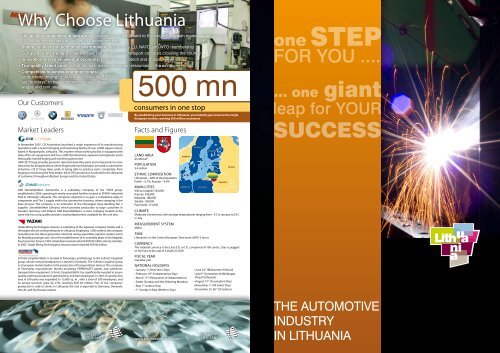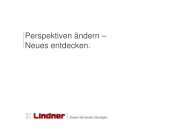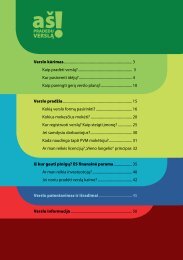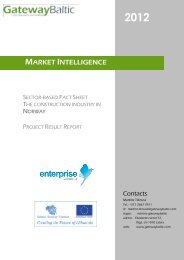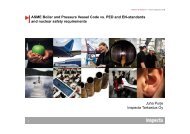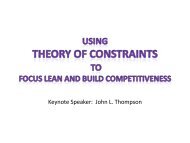SUCCESS - Versli Lietuva
SUCCESS - Versli Lietuva
SUCCESS - Versli Lietuva
You also want an ePaper? Increase the reach of your titles
YUMPU automatically turns print PDFs into web optimized ePapers that Google loves.
Why Choose Lithuania<br />
• 500 million consumers in one stop: Lithuania is a springboard to the single european market, counting over<br />
500 million consumers as well as to eastern markets.<br />
• Stable political and economic environment: ensured by eU, nATO and WTO membership<br />
• Europe’s prime transport centre: two Trans-european transport corridors crossing the country<br />
• Innovation-driven knowledge economy: global laser, biotech and IT leadership<br />
• Top-quality talent pool: one of the best educated human resources in the world<br />
500 mn<br />
• Competitive business operation costs:<br />
productivity-driving profit tax incentives for r&d,<br />
tax “holidays” in free economic zones; competitive<br />
wages and rent rates<br />
Our Customers<br />
Market Leaders<br />
In November 2007, CIE Automotive launched a major expansion of its manufacturing<br />
operations with a new hot forging and machining facility of over 12000 square meters,<br />
based in Marijampole, Lithuania. This modern metal working facility is equipped with<br />
state of the art equipment and has a staff of professional, experienced engineers and a<br />
thoroughly trained forging and machining personnel.<br />
UAB CIE LT Forge provides precision steel and steel alloy parts and components to close<br />
tolerances for all applications where forged and machined parts are used in automotive<br />
industries. CIE LT Forge takes pride in being able to produce parts completely, from<br />
forging to machining the final details. All of CIE’s production is tailored to the demands<br />
of customers throughout Western Europe and the United States.<br />
UAB Stansefabrikken Automotive is a subsidiary company of the STAFA group,<br />
established in 2006, operating in newly renovated facilities located in STAFA’s Industrial<br />
Park in Ukmergė, Lithuania. The company’s objective is to gain a competitive edge in<br />
component and Tier 2 supply within the automotive business, where stamping is the<br />
base process. The company is an extension of the Norwegian long-standing Tier 2<br />
supplier, Stansefabrikken Lillesand, which provides production to large customers in<br />
Sweden, Germany and Poland. UAB Stansefabrikken, a sister company located at the<br />
same site, has a top quality powder coating department, available for the unit also.<br />
Yazaki Wiring Technologies <strong>Lietuva</strong> is a subsidiary of the Japanese company Yazaki, and is<br />
the largest electric wiring enterprise in Lithuania. Employing 1,300 workers, the company<br />
manufactures the latest generation electrical wiring assemblies (ignition system wires)<br />
for Renault passenger cars. Since the establishment of its assembly plant in the Klaipėda<br />
Free Economic Zone in 1993, Yazaki has invested a total of EUR 30 million into its activities.<br />
In 2007, Yazaki Wiring Technologies <strong>Lietuva</strong> turnover reached EUR 96 million.<br />
Schmitz Cargobull Baltic is located in Panevėžys, and belongs to the Schmitz Cargobull<br />
group, whose central headquarters is based in Germany. The Schmitz Cargobull group<br />
is a European market leader in the production of transportation devices. The company<br />
in Panevėžys manufactures thermo-insulating FERROPLAST panels and isothermic<br />
transportation equipment. Schmitz Cargobull Baltic has significantly invested to assure<br />
quality, optimize production optimization, and train employees. In 2007, its production<br />
area in Lithuania was expanded to 15,000 sq. m , with a total of 300 employees, and<br />
its annual turnover grew by 27%, reaching EUR 63 million. Part of the company’s<br />
production is sold to clients in Lithuania; the rest is exported to Germany, Denmark,<br />
the UK, and the Russian market.<br />
consumers in one stop<br />
By establishing your business in Lithuania, you instantly get access to the single<br />
European market, counting 500 million consumers<br />
Facts and Figures<br />
LAND AREA<br />
65,300 km²<br />
POPULATION<br />
3.4 million<br />
ETHNIC COMPOSITION<br />
Lithuanian – 84% of the population,<br />
Polish – 6.1%, Russian – 4.9%<br />
MAIN CITIES<br />
Vilnius (capital): 556,000<br />
Kaunas: 358,000<br />
Klaipėda: 186,000<br />
Šiauliai: 128,000<br />
Panevėžys: 115,000<br />
CLIMATE<br />
Moderate Continental, with average temperatures ranging from - 5 C in January to 23 C<br />
in July<br />
MEASUREMENT SySTEM<br />
Metric<br />
TIME<br />
Lithuania is in the Central European Time zone: GMT+2 hours<br />
CURRENCy<br />
The national currency is the Litas (LTL or LT), comprised of 100 centas. Litas is pegged<br />
to the Euro at the rate of 3.4528 LTL/EUR<br />
FISCAL yEAR<br />
Calendar year<br />
NATIONAL HOLIDAyS<br />
• January 1 st (New year‘s Day)<br />
• February 16 th (Independence Day)<br />
• March 11 th (Restoration of Independence)<br />
• Easter (Sunday and the following Monday)<br />
• May 1 st (Labour Day)<br />
• 1 st Sunday in May (Mother‘s Day)<br />
www.businesslithuania.com<br />
• June 24 th (Midsummer Festival)<br />
• July 6 th (Coronation of Mindaugas,<br />
King of Lithuania)<br />
• August 15 th (Assumption Day)<br />
• November 1 st (All Saints’ Day)<br />
• December 25-26 th (Christmas)<br />
one STEP<br />
FOR YOU ....<br />
... one giant<br />
leap for YOUR<br />
<strong>SUCCESS</strong><br />
The AUTOMOTIVe<br />
IndUsTry<br />
In LIThUAnIA
Market Opportunities<br />
• Competitive and qualified labour force<br />
• Long-standing metal processing traditions<br />
• Highly competitive logistics from Lithuania to Central Europe, a major European automotive industry cluster<br />
• Highly effective industry work expenditure<br />
• Experience in international production chains, and recognition of large international companies<br />
• Reserves for increasing labour efficiency<br />
• Possibility to make use of financial support to increase labour force productivity, and for the development of<br />
the high technology industry<br />
• Market expansion potential: Lithuania may be of considerable interest to Western<br />
companies trying to penetrate the vast Russian market, or the markets of other CIS<br />
countries Highly competitive logistics<br />
from Lithuania to central Europe,<br />
in terms of both time and cost<br />
Industry Overview<br />
The automotive industry generates about 6% of the total added<br />
value created by manufacturing companies and accounting for<br />
around EUR 271 billion per annum. The sector is largely oriented toward<br />
specialist component production, with a particular focus on<br />
wiring devices (there is a strong electronics specialization within the<br />
Lithuanian workforce).<br />
Small but Cascading Forward<br />
In 2008, the transport equipment industry demonstrated excellent<br />
growth as its value added at constant prices rose by almost 18% compared<br />
to the previous year. In 2004–2006, the automotive industry grew<br />
at the fastest pace compared to most economic activities. However, in<br />
2007 the sector experienced some fluctuation due to a decrease in the<br />
production of electronic equipment for transportation devices.<br />
Growth of Gross Value Added<br />
%<br />
45<br />
40<br />
35<br />
30<br />
25<br />
20<br />
15<br />
10<br />
5<br />
0<br />
19.4 19.6<br />
10.7<br />
13.0<br />
14.9<br />
4.8<br />
14.0<br />
5.7<br />
2000 2001 2002 2003 2004 2005 2006 2007 2008<br />
Manufacturing of transport equipment<br />
Manufacturing<br />
Source: Lithuanian Department of Statistics<br />
38.6 38.8<br />
11.8<br />
23.0<br />
8.6 9.5<br />
7.7<br />
4.8<br />
17.7<br />
1.6<br />
The volume of sales increased by almost 20% in 2008 compared to<br />
2007. Despite the global economic downturn, the industry retained its<br />
growth in the first half of the year, in contrast to the majority of industries.<br />
Various transport parts for Volkswagen, Mercedes, BMW, Renault,<br />
Volvo, SAAB, Dacia, etc., have been produced by the Lithuanian automotive<br />
industry. Therefore, over two-thirds of automotive output has<br />
been sold on foreign markets. Exported growth in value for 2007-2008<br />
accounted for 9%. In 2008, more than a half of exports went to the CIS<br />
as a result of the eastward re-export of second-hand cars. However,<br />
the bulk of transport (mostly automotive) components of Lithuanian<br />
origin goes to EU-15 member countries (particularly Germany, Sweden,<br />
Denmark and the UK) and the markets of new EU countries. Since<br />
2008, new export markets – Azerbaijan, Afghanistan, Turkmenistan,<br />
Iraq, UAE, Bosnia and Herzegovina, Bolivia, and Thailand – have been<br />
discovered by Lithuanian transport equipment producers.<br />
Sales of Motor Vehicles and Other Transport Equipment<br />
EUR M<br />
500<br />
450<br />
400<br />
350<br />
300<br />
250<br />
200<br />
150<br />
100<br />
50<br />
0<br />
114.1<br />
17.4<br />
108.6<br />
30.4<br />
123.7<br />
52.4<br />
91.8<br />
118.7 130.6 147.1<br />
2002 2003 2004 2005 2006 2007 2008<br />
Source: DnB NORD Bank<br />
157.6<br />
Exports Domestic sales<br />
214.6 264.1<br />
324.1<br />
Components Predominate<br />
The sector is largely oriented toward component production, with a<br />
particular focus on wiring devices as there is a strong electronics specialization<br />
within the Lithuanian workforce. Within the components<br />
sector, the main segment is the wire and cables industry, accounting<br />
for 77% of output. There are several key players in the sub-sector, producing<br />
components for Volkswagen, Renault, Volvo Trucks, Dacia, and<br />
SAAB. Moreover, the newest models of Mercedes and BMW will soon<br />
be provided with parts made in Lithuania.<br />
Aside from automotive wiring, the components sector also includes<br />
specializations in the following segments: electronics, oil and air filters,<br />
brake systems, air compressors, diesel engines, windows and hitches.<br />
Market Share by Auto Components<br />
Wires & cables<br />
Market Share<br />
79%<br />
Bodies of motor vehicles 8%<br />
Engine parts 2%<br />
Laminated glass 3%<br />
Fuel, oil & air filters 2%<br />
Compressors 3%<br />
Other motor vehicle components 3%<br />
Productivity on the Rise<br />
There were 37 manufacturers of motor vehicles and 48 manufacturers<br />
of other transport equipment in Lithuania at the beginning of<br />
2009. While there are a few large employers, the industry is generally<br />
dominated by small- and medium-sized players, with most companies<br />
employing up to 50 workers. While the number of workers in the<br />
manufacturing industry has continued to decline, the workforce in the<br />
motor vehicles and manufacturing sector has increased by almost 8%<br />
to 8.4 thousand.<br />
Labour productivity in the transport equipment sector was approximately<br />
one fifth above the manufacturing industry average in 2008,<br />
although the annual growth of this indicator was much smaller than<br />
across the manufacturing industry. Value added per worker increased<br />
by about 14%.<br />
For a third year in a row, the average profitability of automotive companies<br />
has been higher than the manufacturing industry’s average. It<br />
remained quite respectable in the second half of 2008, when profit<br />
margins across the manufacturing industry shrank dramatically.<br />
Gross Profit Margin<br />
%<br />
Source: BMI<br />
30<br />
25<br />
20<br />
15<br />
10<br />
5<br />
0<br />
16.7<br />
19.3<br />
21<br />
16.2<br />
18.1<br />
25.4<br />
16.9<br />
19.6 18.3 17.8<br />
3.1<br />
17.4 16.7 17.2<br />
14 16.7 14<br />
7.8<br />
13.9 16.2<br />
17.6<br />
15 15.3 15.6<br />
22<br />
24.7<br />
19.3<br />
12.6 12.1<br />
10.6<br />
6.2<br />
21.7<br />
26.4<br />
27<br />
22.8<br />
21.1 20.3<br />
18.7 18<br />
28.4<br />
24.4<br />
20.3<br />
2006<br />
Q1<br />
2006<br />
Q2<br />
2006<br />
Q3<br />
Manufacturing<br />
2006<br />
Q4<br />
2007<br />
Q1<br />
2007<br />
Q2<br />
Source: Lithuanian Department of Statistics<br />
2007<br />
Q3<br />
2007<br />
Q4<br />
2008<br />
Q1<br />
2008<br />
Q2<br />
2008<br />
Q3<br />
2008<br />
Q4<br />
2009<br />
Q1<br />
2009<br />
Q2<br />
Manufacture of motor vehicles, trailers<br />
Manufacture of other transport equipment<br />
Investing in the Long-term<br />
FDI has been a key driver for the growth of automobile manufacturing<br />
in Lithuania. Scandinavian countries like Denmark and Sweden<br />
as well as Western European countries like Germany and France<br />
have been the largest sources of FDI for Lithuania. Manufacturing<br />
transport equipment is one of the dominant sectors, which has been<br />
witnessing an appreciable level of FDI in the past few years.<br />
At the beginning of 2009, the value of accumulated FDI accounted<br />
for EUR 111 million and increased by 13.3% when compared to 2008.<br />
The bulk of investment came from Estonia (34.2% of total FDI), Germany<br />
(33.2%) and Denmark (25.9%). Some of the major European<br />
automotive industry players from Germany, France, Spain, and Norway<br />
have already invested in Lithuania and moved their production<br />
facilities here.<br />
Currently, the majority of Lithuanian automotive companies are lower<br />
level suppliers internationally of major OEMs, cooperating with Tier<br />
1 or Tier 2 suppliers. However, there are some positive trends associated<br />
with the transfer of greater responsibility to local producers.<br />
Among the new EU countries, Poland, Hungary, and the Czech Republic<br />
are clearly in the lead in terms of automotive industry magnitude,<br />
and have taken in significant foreign investment. In spite of<br />
its considerably smaller automotive industry production, Lithuania<br />
exceeds the average of the new EU member states according to the<br />
effectiveness of the labour force cost.<br />
FDI Trends<br />
EUR M<br />
160<br />
120<br />
80<br />
40<br />
0<br />
76<br />
3188 3334<br />
273926712474<br />
2583<br />
2524<br />
2098<br />
4000<br />
3000<br />
2000<br />
1594<br />
1000<br />
3515<br />
3789<br />
3428<br />
3323<br />
3693 3645 2824<br />
81<br />
83<br />
2630<br />
80 85 83 84 2122 2157<br />
92 94 90 99 122<br />
111106 93 98 104 110 108<br />
2005<br />
Q1<br />
2005<br />
Q2<br />
2005<br />
Q3<br />
2005<br />
Q4<br />
2006<br />
Q1<br />
2006<br />
Q2<br />
2006<br />
Q3<br />
2006<br />
Q4<br />
2007<br />
Q1<br />
Manufacturing Transport equipment<br />
Source: Lithuanian Department of Statistics<br />
2007<br />
Q2<br />
What Makes Us Competitive?<br />
� Although small, Lithuania has a good reputation for quality work at<br />
affordable prices, due to its highly skilled (but cost-efficient) workforce.<br />
However, the country’s gross average monthly wage is still<br />
considerably lower than that in Western Europe countries and even<br />
some of new member states (EUR 620).<br />
� Lithuania has an advantage in that its membership in the EU and its<br />
proximity to Scandinavia and Russia assures flexibility to satisfy small<br />
and custom orders while making it an ideal manufacturing hub for<br />
supplying the region’s auto plants.<br />
� Seeking to increase the automotive industry’s competitiveness,<br />
companies are working in the same direction as the entire engineering<br />
industry to improve their activities: the creation and production<br />
of goods and services with higher added value, implementation<br />
of new business models, modernization of production, human resource<br />
development, and R&D expansion.<br />
2007<br />
Q3<br />
2007<br />
Q4<br />
2008<br />
Q1<br />
2008<br />
Q2<br />
2008<br />
Q3<br />
2008<br />
Q4<br />
2009<br />
Q1<br />
2009<br />
Q2<br />
2009<br />
Q3<br />
0


